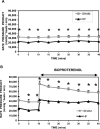The absence of endogenous lipid oxidation in early stage heart failure exposes limits in lipid storage and turnover
- PMID: 18155232
- PMCID: PMC2276319
- DOI: 10.1016/j.yjmcc.2007.11.006
The absence of endogenous lipid oxidation in early stage heart failure exposes limits in lipid storage and turnover
Abstract
Intramyocardial lipid handling in pressure-overload-induced heart failure remains poorly understood, and the balance between endogenous and exogenous lipid utilization for mitochondrial ATP production is essentially unknown. In this study, we determined the contribution of endogenous triacylglycerols (TAG) to mitochondrial oxidation relative to that of exogenous palmitate, glucose, and endogenous glycogen in the failing, pressure-overloaded rat heart. TAG content and turnover were also assessed to determine if lipid availability and mobility were altered. Dynamic-mode (13)C NMR was performed in intact hearts from aortic banded and sham operated Spraque-Dawley rats perfused with (13)C-labeled palmitate or glucose to assess TAG turnover rate and palmitate oxidation rate. The fractional contributions from palmitate, glucose, glycogen, and TAG to mitochondrial ATP production were determined from NMR analysis of heart extracts. TAG oxidation was not evident in HF, whereas the contribution of TAG to oxidative ATP production was significant in shams. TAG content was 39% lower in HF compared to sham, and TAG turnover rate was 60% lower in HF. During adrenergic challenge, TAG sources were again not oxidized in the HF group. In early cardiac failure, endogenous TAG oxidation was reduced in parallel to increased carbohydrate oxidation, with no change in exogenous palmitate oxidation. This finding was consistent with reduced TAG storage and mobilization. These data further elucidate the role of intermediary and lipid metabolism in the progression of LVH to failure, and contribute to emerging evidence linking the disruption of myocardial substrate use to cardiomyopathies.
Figures






References
-
- Neely JR, Morgan HE. Relationship between carbohydrate and lipid metabolism and the energy balance of heart muscle. Annu Rev Physiol. 1974;36:413–459. - PubMed
-
- O'Donnell JM, Zampino M, Alpert NM, Fasano MJ, Geenen DL, Lewandowski ED. Accelerated triacylglycerol turnover kinetics in hearts of diabetic rats include evidence for compartmented lipid storage. Amer J Physiol Endocrinol Metab. 2006;290:E448–455. - PubMed
-
- Saddik M, Lopaschuk GD. Myocardial triglyceride turnover and contribution to energy substrate utilization in isolated working rat hearts. J Biol Chem. 1991;266(13):8161–8170. - PubMed
-
- Sorokina N, O'Donnell JM, McKinney RD, Pound KM, Woldegiorgis G, Lanoue KF, et al. Recruitment of compensatory pathways to sustain oxidative flux with reduced carnitine palmitoyltransferase I activity characterized inefficiency in energy metabolism in hypertrophied hearts. Circulation. 2007;115(15):2033–2041. - PubMed
-
- Schaffer JE. Lipotoxicity: when tissues overeat. Curr. Opin. Lipidol. 2003;14(3):281–287. - PubMed
Publication types
MeSH terms
Substances
Grants and funding
LinkOut - more resources
Full Text Sources
Medical
Research Materials
Miscellaneous

